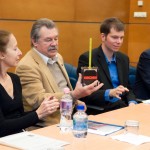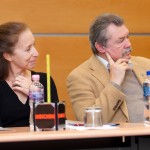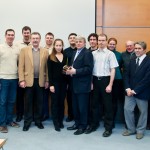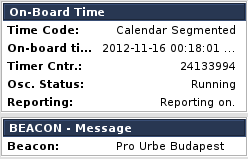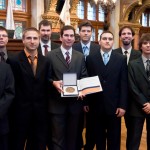It is business as usual in terms of operating Masat-1 in the winter. At our Primary Station in Budapest we are observing and following the daylight portion of the orbits. During these passes we are initiating data acquisitions and programing the camera module to take photos. Log files, data and photos taken earlier are being downloaded continuously. Amateur radio operators’ contribution to this process is a great help to our team.
We have also made some improvements regarding our satellite receiver hardware and software. For instance, the software has been supplemented with an automatic frequency control (AFC) module. Among other things this was necessary because the current receiving frequency is calculated based on orbit data, and even though we have more accurate orbit data than before, sometimes small adjustments might still be necessary for successful demodulation. Until now we have been doing it manually. Now the task is carried out automatically by software.
People might have noticed that there have been some changes regarding the antenna system on the roof of building E of BME. A new lightning protection system has been installed around the YAGI antennas, which will be very useful in the spring. A parabolic antenna has been moved from building V2 of BME to building E, which we would like to use during high-speed communication with next generation Masat satellites. Making the 2.2-2.4 GHz S-band fully operational still requires a lot of work and financial sacrifices. Nevertheless, students of the Department of Broadband Infocommunicatons and Electromagnetic Theory have already started designing the system. Levente Pápay has reported on the current status of the project in his Scientific Students’ Associations research paper.
Meanwhile, at the Secondary Station in Érd, we are focusing on the night portion of the orbits. This is a great opportunity to experiment with Masat-1’s so far rarely used function. According to our website, the data transmission of the communication system is most reliable between 625 bps and 1250 bps. At this speed it takes five to six passes to download a picture (approximately one to two days). We have left open the possibility of modifying it later, so it can be set to 5000 bps (5kbps). This mode, however, requires a special receiver instrument. We are currently using the Universal Software Radio Peripheral (USRP) device made by National Instruments. If everything goes according to plan, this faster download function will be fully operational in a few months.
We had an extraordinary opportunity to meet with Marsha Ivins, who held an entertaining presentation at the Budapest University of Technology and Economics about the past, present and uncertain future of human spaceflight.
Before the presentation we met her and introduced the story of the satellite development and the achievements we reached. Pictures taken during the event can be found in our gallery.
On 23 November 2012 we have received the two millionth packet coming exclusively from members of the radio amateur community. The packets had been submitted to Masat-1 Ground Station by e-mail or using our client SW.
The received packets were of high significance for the team, enabling the supervision and tracking of satellite status all around the world. Contributors also enabled the simpler and faster downlink of images and measurement data.
On this occasion we updated the reception statistics page.
We would like to thank the radio amateur community for their enduring support.
Marsha Ivins is giving a public lecture in English about the past, present and uncertain future of human spaceflight at the Faculty of Electrical Engineering and Informatics (BME VIK) of the Budapest University of Technology and Economics (BME) on December 6.
The Faculty of Electrical Engineering and Informatics of BME, the Hungarian Astronautical Society and the Embassy of the United States of America invites you to Marsha Ivins’s presentation ’Human Spaceflight, past, present and uncertain future’.
Date and venue: 6 December 2012, 3:00 p.m. at BME, building I, room I.B.025 (2 Magyar tudósok krt., Budapest, 1117).
Marsha S. Ivins is an engineer at Lyndon B. Johnson Space Center and has travelled to space five times as a crew member of Space Shuttles Columbia and Atlantis. She has spent more than 55 days in space during her 1990, 1992, 1994, 1997 and 2001 space travels. She has been to both Mir and the International Space Station. The astronaut – originally an engineer – is going to talk about the past, present and uncertain future of human spaceflight.
To attend the presentation, please register at BME VIK’s website.
University
Cooperation
Sponsors
- AduPrint
- Altium
- Anico Kft.
- Azurspace
- BL-Electronics
- Bonn Hungary
- Carinex
- ChipCAD
- COOPTIM Ipari Kft
- Dension
- DND Telecom Center Kft.
- DSI Informationstechnik
- Dunaújvárosi Főiskola
- EADS Astrium GmbH
- ELMŰ
- Europrint
- Evosoft
- Exasol Kft.
- Faludi Wolf Theiss
- Farmelco Kft.
- GD Gép és Daru Kft.
- HFT Kft.
- HP Magyarország
- Hungaro DigiTel Kft.
- Infoterra Hungary Kft
- KFKI RMKI
- LHT Budapest
- LOMEX
- Magnetec-Ungarn
- Magyar Villamos Művek
- Magyarok a Marson
- Microchip
- National Instruments
- Nikon
- NMHH
- NuSil
- Paksi Atomerőmű
- Puskás Technikum
- Rádióvilág
- Ricoh Hungary Kft.
- RSOE
- Sagax Kft.
- SGF Kft.
- Siemens
- Silicon Labs
- Sphere Consulting Kft.
- Totaltel
- Űrvilág Hírportál
- Wacker Chemie
Design tools
Calendar
| M | T | W | T | F | S | S |
|---|---|---|---|---|---|---|
| 1 | 2 | 3 | 4 | 5 | 6 | |
| 7 | 8 | 9 | 10 | 11 | 12 | 13 |
| 14 | 15 | 16 | 17 | 18 | 19 | 20 |
| 21 | 22 | 23 | 24 | 25 | 26 | 27 |
| 28 | 29 | 30 | 31 | |||





